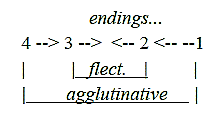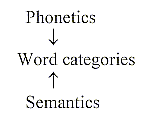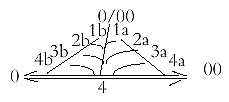|
Different types of languages:
In topological classification of languages linguists use
to divide them in about 5 main types. It must be added however
that hardly any language or family is purely of one variant.
The five types are designated:
- Isolating languages (analytical or root languages)
- Agglutinating languages
- Inflecting languages
- Polysynthetic or incorporating languages
- Analytic languages
Could these different types be interpreted with help of
aspects in a dimension chain?
Isolating languages:
One typical example: Chinese:
Some features according to the literature:
- Isolated, rigid morphemes as words, no endings. (Much
of monosyllabic morphemes.)
- "Word classes" not defined by the shape, instead
through word order and use of "auxiliary words",
e.g. "wisdom" = "thing" + "wise",
(LL).
- Movements in intonation are significant factors in separating
sense.
- A current development towards more form words and more
mobility of these form elements.
The feature that parts of speech not are designed as such,
that the morphemes to a great degree correspond to complex
concepts that can be both nouns, verbs and adjectives, etc.,
allow us to regard the type of language as high-dimensional
relative to other types on the level of word classes. Note,
however, that pronouns exist; cf. the interpretation of
pronouns as derived from primary poles 0 —
00 from step 5→4.
The interpretation may also be justified
by the scripture, with much preserved from a historically
early stage of ideograms and signs that have indicated concepts
through depicting entire situations.
A simple "grammar", where the
class of words gets defined through the complex whole and
word order as direction of the sentence and intonation,
seems to imply that much of "syntax" or the listener's
interpretation have to rely on the speech situation, here
suggested as from step 5→
4 in the level chain. It seems to be the case for such items
as tense for instance, judging from given examples. ("Direction"
as d-degree 4 first from situation of speech.)
The trend towards more "form words" as debranched
quanta could be taken as a general indication of steps from
higher dimension degrees to lower ones.
However, in opposition to these "high-dimensional"
views, some linguists believe that simple words in Chinese
are reduced ones and at an earlier stage were two- or multi-syllable
words. This means that many different words with different
meanings coincided when reduced, converging to the same
morpheme. Bjorn Collinder (BC,s) for instance suggests
a trend towards an isolating language as towards a late
stage of simplification. It is pointed out as one example
that Modern English has developed many features of an "isolating"
language type.
The simple grammar can also be described as 1-dimensional,
a quantification where sense of the message is designed
in the additive, linear word order (O--O--O--O...).
Since intonation also is crucial for the
semantic meaning, we could find a connection with step 1→
00 in the dimension chain, the step towards the d-degree
of motions as motion of tone.
The two opposite views imply
a) a complex semantic sense of morphemes, not yet
differentiated in word classes and with intonation, in itself
probably a very deep level of "language,"
b) the complexity as a reduction to simple often
monosyllabic morphemes where only a linear (as 1-dimensional)
grammar decides the sense and word classes. (Cf. morphemes
in the big level chain assumed as the level characterized
in step 2 —1.)
Hence, it's suggested here to regard this
family type with features of both 1st and last step in the
dimension chain, steps corresponding in the loop model:

Agglutinating and Inflecting languages:
Agglutinating languages, (sometimes also called
inflectional):
Typical examples: Uralic languages, Turkish, Japanese, Swahili,
Etruscan. (Etruscan is said to have strong features of an
agglutinating language. It had pronouns, but mostly suffixes
instead of prepositions.) Some features according to the
literature, most of them existing in Uralic languages:
- Rigid word stems (radicals), rich in inflectional endings,
i.e. with many suffixes.
(Or many prefixes as in Swahili.)
- Suffixes (or prefixes) get lined one after the other.
- Each suffix has one grammatical function.
- Often vowel harmony, vowel of suffixes resembles
the word stem.
- Many cases develop. (Uralic 6, became 15-16 in Finnish,
about 25 in Hungarian.)
(As in Finnish, the Etruscan didn't differentiate genders
he / she, only personal versus non-living things,
hence in gender less differentiations than in Indo-European.)
Inflectional languages:
Typical examples: Indo-European, Latin, Arabic (Semitic)
languages. Some features according to the literature:
- Type of word class is marked by separate morphemes.
- Stems can be inflected through vowel change, for instance
through "umlaut" in plural forms, or in tense
inflection in the "strong verbs". The vowel alters
to resemble the one in suffixes.
- Several different grammatical functions can be expressed
with only one (1) suffix.
- Quite a few cases (2 in IE, 6 in Latin, 5 in ancient Greek,
4 in Old Swedish).
- Verb endings instead of pronouns (as in agglutinative
languages, mainly 1st and 2nd person).
- The original word stems said to be verbs.
- Indo-European did not know prepositions but words for
directions as additions.
Semitic languages among the inflectional ones were previously
agglutinating (LB).
A suggestion of how to regard the relation
between these two families in the dimension chain:

One general aspect here is of course that double-direction
in the loop model towards the middle in step 3-2 implies
inflection as such, increasing toward the middle. Compare
the angle step 4 → 3, assumed
as a step in polarity type from 180° to 90°.

Comparison agglutinating - inflecting languages:
It has been discussed if the features of inflecting languages
are older than that of the agglutinating ones or the inverse.
A linguist as Bjorn Collinder points out that language development
isn't unidirectional.
A direction agglutinating ——> inflectional languages = towards increasing complexity,
may be regarded as towards a higher dimensional level. So
does the opposite direction too, through angle steps complicating
the structure. Both aspects can be reconciled in the loop
model of the dimension chain above.
a) Morphemes:
It's possible to find a contradiction too in the direction
of differentiations of word stems: the separation of radicals
from within the semantics through narrowing "base formants",
more pronounced in agglutinating languages (?), - compared
with word stem "classes" of e.g. Latin after end
phonemes, i. e. from the outer level of phonetics?

If initial morphemes in agglutinating languages are branched
into verbs and nouns (ambiguous in reference BC),
it could be interpreted as the first differentiation of
word classes (parts of speech), after the isolating languages
and their concepts.
The inflecting languages as Indo-European
on the other hand, where the development of morphemes is
said to have gone from verb stems to nouns (V →
N), should in that case imply a relation at straight angle
to the agglutinating languages in this respect.
V
< |
N

b) Vowel harmony - vowel changes:
About vowel changes in suffixes and word stems, agglutinating
languages may be regarded as an "earlier" stage
dimensionally, seen in outward direction: stems are indeclinable
in agglutinating languages - as in isolating ones. Vowel
change concerns the endings of words = outwards in words.
("Vowel harmony".)
In inflecting languages, word stems may
also change, e.g. to more similarity with the endings, an
effect inwards in the words, as a turning towards inward
direction in the chain of steps 3 —><—2.
Vowel harmony in agglutinative languages is also
a phonetic history: the superimposed phonetic level
"from outside" acts as 'a bending force'.
While the verb stems in inflectional languages may be regarded
as inflected by and in service of grammar, e. g. in tenses
in "strong verbs", as from the "deeper"
level of syntax.
c) System of affixes:
The system for affixes in the secondary differentiations
within word classes shows the most characteristic difference
between agglutinating and inflecting families. A comparison,
if the principle of endings (according to CEL) is
purified:
- Agglutinating languages: affixes are added one
after another, e. g.:
noun + affix 1 + affix 2 + affix 3 etc. One example from
Swedish, although not belonging to this family: kung-ar-na-s
(= the Kings' in genitive):
(noun) + -ar (plural) + -na (definite form)
+ -s (genitive).
- Inflectional languages as Latin: many such secondary
determinations as tense, person etc. are expressed with
one and the same suffix.
The principle could be interpreted as a difference in dimension
degrees:
- Addition (+) implies a linear, 1-dimensional operation.
- Multiplication (x) implies a 2-3-dimensional operation,
as defining squares or in two steps cubes.
In the inflectional system the suffixes may be interpreted
as points in a plane or space geometry, to regard as result
of further development inwards:
Inflecting languages could be compared with
"sp-
(spd-)hybridizations" in molecule bonds.
Hence, we would have the two systems for
added suffixes in the lower degrees of the loop model:
Agglutinating languages in step (2)←1,
inflecting ones: step (3)←2
- as in the figure already shown:

This is also in agreement with the assumption that agglutinating
languages represent an earlier, deeper and more high-dimensional
type. Cf. the statement that Semitic languages (inflectional)
earlier was agglutinating.
Swahili with prefixes, an inverted direction
in this respect compared with Uralic, could perhaps represent
a still earlier phase in these agglutinating languages,
nearer as it is the origin of Homo Sapiens.
d) Number of cases and other suffixes:
The increasing number of cases in agglutinating languages
could be an expression of direction outwards (d-degree pole
4b) in the secondary chain of noun differentiations, e.g.
in all their different cases for locality.
The agglutinating type is geometrically
(grammatically) less complex than the inflecting, but more
complex than the isolating one.
The additive principle is probably one reason for the possibility
to develop and manage this significantly higher number of
cases than in a language as Latin?
In the typical inflectional Latin the number of noun inflections
(AA) resembles number of electrons in different orbitals
in atomic shells:

(18 + 5 is also = number of non-metals + transition elements
in the Periodic system!)
Assuming that there are no endings coinciding and all
distinctions gave suffixes, it should give 2 x 6 x 10
x 5 suffixes = 600 endings to remember? Up to 4 selected
and united to 1 suffix for a noun.
With the Latin system purified the
verbs should get about at lest 1440 endings! (5 moods
x 2 = active / passive voice, x 3 for persons x 2 for
number, x 6 for tenses including duration, x 4 verb
stems after final vowel, (4 "conjugations")
?!
The vowel change inwards to the word stem in e. g. tenses
reduces of course the need for suffixes. It could perhaps
be regarded as a kind of infix too.
It seems also to exist a difference of degree within inflecting
languages themselves, as in the relationship between Semitic
and Indo-European languages:
In the 3-consonantal word stems of Semitic
languages, (where the vowels often indicated grammatical
features as in the strong verbs of IE), the 3rd consonant
had the function to shade off and differentiate sense, was
a kind of semantically narrowing suffix (LB).
In the similar word stems of Indo-European,
this 3rd consonant was (mainly in verbs) reversed to an
infix, position number 2. (LB)
This shift in position seems as a further
step of turning inwards in direction, an inflection on the
level of both semantics and phonetics, opposite ends of
the level chain.. Note. 3 —>
2 +1, in the number of consonants.

Polysynthetic ( "transposition") languages:
Typical examples: Eskimo language, (some?), Indian languages
and Australian languages (some or most of them?). Basque
is reported to have some of these features.
- Many clause elements are incorporated into the verb,
so it's said, hence the term "synthesizing". The
type has also been described as "multi-articulated
sentences grown together into word bodies" (BC, s).
- The language type is said to have some similarities with
both agglutinating and inflecting languages.
- Secondary grammatical qualifiers are often "infix".
Direction of "synthesis" is inward direction
in a dimension chain (from d-degree 0/00).
If verbs are interpreted as "directions", i.e.
as expressions for the 4th d-degree on the level of word
classes, the later d-degree steps may be regarded as developed
and differentiated within the outer poles 0 and 00 of d-degree
4, in this sense potentially (virtually) "incorporated"
in the verbs.
With a couple of alternative sketches
of this principle from previous parts and other files here:


A secondary chain of steps within Potentials growing towards
lower
the step 4→3 on the level
of d-degrees and stepwise turning towards
word classes /parts of speech). more circular structure.
However, it is difficult to see all three examples below
as clause elements incorporated in the verbs. (It's obvious
that pronouns come first, as suggested before: pronouns
as originally from outer poles 0- and 00 in speech situation,
defining d-degree 4.)

* (Infinitive, is also known in Latin grammar as "verbal
noun", hence a step towards d-degree 3.)
In both examples, the "words" seem to illustrate
the differentiation steps within the word class verbs, for
instance in first giving the intransitive verb, then the
step to unidirection, the transitive form.

Here the wished object gets the role of centre, followed
as in the word class chain by an adjective. Then the verb,
as hauling in this object, then the mood "optative"
of the verb as affix, last arriving at the formal subject,
only as affix of to the verb. (Cf. about moods.)
Should such a language be interpreted as an early or a
late stage?
With respect to the morphemes - or parts of the words,
it seems as if that which in agglutinating and inflecting
languages is only affixes, has more substance (left?). As
adverbial morphemes - from a role of independent expressions?
(The prehistory of tenses in inflecting languages?)
Polysynthetic languages are spoken by what linguists call
"border people". By applying a linguistic theory
within phonetics, they would correspond to an older language
type.
If so, they have also had a longer time
to develop. With respect to syntax, it could imply a secondary
synthesis of previously developed, more distinct, separated
words - the result of "abbreviations", made possible
within isolated language groups?
Cf. the immune system, where an "alphabet"
of 3 amino acids are said to exist (?). Like our type
of abbreviations, ABB, SKF etc.: to regard as a superposed
level of language. A "later" development of
abbreviations.)
An additional question: If western linguists hear a row
of sounds (calling them word-bodies), not understanding
the language, why shouldn't those people hear western speech
in the same way, as just a row of sounds we call phonemes?
And what's the conclusion? It seems as if we have to regard
the "polysynthetic" languages as in both main
directions in a "haploid" chain:
0 <= 4 == 3 =><= 2 == 1 ==> 00, where the inward
direction (as from phonemes in that gradient of the big
level chain !) is chosen in the name.
Cf. "infix" as in the middle step. Basque for
instance has many infixes.
Analytical language:
Typical examples: the development of the Latin language
as inflecting to its daughter languages.
Features according to the literature:
- More and more "free form-words". "independent
words" and word categories replaced endings.
- Pronouns replaced the verb endings. 50% of the pronouns
existed in the twelfth century.
- Prepositions developed, were released and replaced case
endings.
- Mood endings on verbs became auxiliaries.
Such a development has been going on, as mentioned about
pronouns and prepositions, not only in Indo-European languages
but also in the Semitic ones and for instance in Chinese.
It has been described as a "grammatical dissolution".
Generally, such languages could be said
to illustrate the steps into lower dimensional degrees—> 2 —
1 — 0/00.
In Uralic (agglutinating) languages for instance, there
has been a development of nouns, which reduced may become
case endings (BC). In inflecting (fusional) languages
one development goes from case endings to prepositions.
Such data imply a gradual reduction outwards of word categories
and a "dissolution" as liberation of quanta.
In terms of the dimensional model steps outwards imply
an increasing number of dimensions translated into motional
moments. Very elementary:

It corresponds to increasing mobility of language "form
elements", which in this sense becomes independent
words.
The trend towards analytical language is here vaguely proposed
as a stepwise substantiation of such "grammatical motions"
as expressions for relations in whole sentences.
Summery:
From the aspect of "development inwards" towards
higher d-degrees:
- Isolating languages: the lining up of isolated words decide
word class, ~ 1.
- Agglutinating languages: the lining up of endings determines
the secondary developments within word classes, ~ 2,
- Inflecting, synthetic or fusional languages: - coordinate
and stores the determinations of secondary chains within
word classes into one (1) suffix, - 3 <—
2,
- Polysynthetic languages: coordinate and store both secondary
and primary chains on the level of word classes in verbs
to "word bodies", ~ 4 <—3.
From the aspect of development towards lower dimensional
degrees:
An increasing differentiation of word categories (the parts
of speech)? From isolating languages to polysynthetic ones
- to agglutinating, - to fusional - to analytic languages.
Then, as a "feedback", or meeting
between opposite poles in terms of the dimension model,
a combination of isolating - analytic characters (?), when
looking at the development underway in contemporary English.
The consecutive order of the development of the different
language types, here sketched with aspects from the dimension
model, becomes essentially the same as Bjorn Collinder suggests
in his book "Språket" ("The Language").

A note:
Geographical distribution on Northern Hemisphere:

*
To part II:
The Speech
Organs
|













